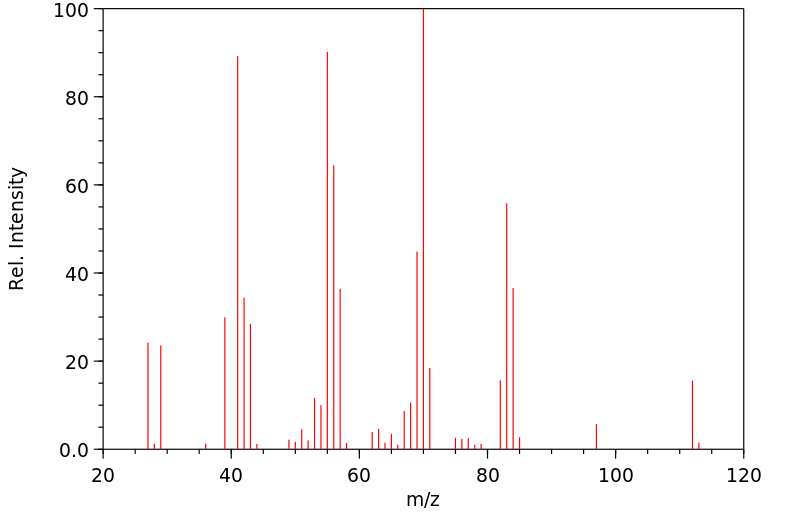4-氯辛烷 | 999-07-5
中文名称
4-氯辛烷
中文别名
——
英文名称
4-chlorooctane
英文别名
4-chloro-octane;4-Chlor-octan;4-Chlor-n-octan;Octylchlorid-4;4-Chloroctan
CAS
999-07-5
化学式
C8H17Cl
mdl
——
分子量
148.676
InChiKey
SRGMFDQMGOZQPO-UHFFFAOYSA-N
BEILSTEIN
——
EINECS
——
-
物化性质
-
计算性质
-
ADMET
-
安全信息
-
SDS
-
制备方法与用途
-
上下游信息
-
文献信息
-
表征谱图
-
同类化合物
-
相关功能分类
-
相关结构分类
物化性质
-
熔点:-41.9°C (estimate)
-
沸点:178.66°C (estimate)
-
密度:0.8765 (estimate)
-
保留指数:997;997
计算性质
-
辛醇/水分配系数(LogP):4
-
重原子数:9
-
可旋转键数:5
-
环数:0.0
-
sp3杂化的碳原子比例:1.0
-
拓扑面积:0
-
氢给体数:0
-
氢受体数:0
SDS
反应信息
-
作为反应物:参考文献:名称:DENO N. C.; GLADFELTER E. J.; POHL D. G., J. ORG. CHEM., 1979, 44, NO 21, 3728-3729摘要:DOI:
-
作为产物:参考文献:名称:澄清基于芳基磺酸盐的亲核助剂离去基团的亲核取代的立体化学过程摘要:当在丙酮中用卤化锂在回流下处理时,被修饰为对甲苯磺酸盐,PEG-磺酸盐或对甲苯磺酸盐的仲醇在反应中心发生构型转化,其中PEG-磺酸盐和对甲苯磺酸盐的反应性更高。在空间受限的情况下,淘汰是一个相互竞争的过程。相反,当用TiCl 4处理时,简单的仲磺酸盐使氯化物产物的构型部分反转。在这些条件下,在给定的烷基磺酸盐底物中观察到的任何构型保留都可能是由于相邻基团的参与或对碳正离子(或离子对)的非对映选择性攻击,而不是S N i机理。DOI:10.1021/jo900991z
文献信息
-
Reactivity of bismuth(III) halides towards alcohols. A tentative to mechanistic investigation作者:El Mehdi Keramane、Bernard Boyer、Jean-Pierre RoqueDOI:10.1016/s0040-4020(01)00013-8日期:2001.3bismuth(III) halides (BiX3; X=Cl, Br and I) towards a series of alcohols has been investigated. Three different reactions have been studied, namely: halogenation, dehydration and etherification. The behaviour of these bismuth derivatives was found to depend on the nature of the halide bonded to the bismuth atom. Their reactivities can be interpreted on the basis of the Hard and Soft Acids and Bases
-
Stereoretentive Chlorination of Cyclic Alcohols Catalyzed by Titanium(IV) Tetrachloride: Evidence for a Front Side Attack Mechanism作者:Deboprosad Mondal、Song Ye Li、Luca Bellucci、Teodoro Laino、Andrea Tafi、Salvatore Guccione、Salvatore D. LeporeDOI:10.1021/jo3023439日期:2013.3.1A mild chlorination reaction of alcohols was developed using the classical thionyl chloride reagent but with added catalytic titanium(IV) chloride. These reactions proceeded rapidly to afford chlorination products in excellent yields and with preference for retention of configuration. Stereoselectivities were high for a variety of chiral cyclic secondary substrates including sterically hindered systems使用经典的亚硫酰氯试剂开发了醇的温和氯化反应,但添加了催化氯化钛 (IV)。这些反应进行得很快,以极好的收率提供氯化产物,并优先保留构型。包括空间位阻系统在内的各种手性环状次级底物的立体选择性都很高。氯亚硫酸盐首先在原位生成并通过四氯化钛的作用转化为烷基氯化物,四氯化钛被认为螯合氯亚硫酸盐离去基团并从正面释放卤素亲核试剂。为了更好地理解这种新的反应途径,使用两种不同的计算方法在 DFT 理论水平上进行了从头研究。这一计算证据表明,虽然反应通过碳正离子中间体进行,但这种带电物质可能保留金字塔几何形状,作为通过超共轭(超共轭体)稳定的构象异构体而存在。然后,这些碳正离子在亲核捕获时基本上“冻结”为其原始构型。
-
Metal-free regioselective hydrochlorination of unactivated alkenes<i>via</i>a combined acid catalytic system
-
Iron(III)-Catalyzed Halogenations by Substitution of Sulfonate Esters作者:Nuria Ortega、Andrés Feher-Voelger、Margarita Brovetto、Juan I. Padrón、Victor S. Martín、Tomás MartínDOI:10.1002/adsc.201000740日期:2011.4.18A novel halogenation reaction from sulfonates catalyzed by iron(III) is described. The reaction can be performed as a stoichiometric or a catalytic version. This reaction provides a convenient strategy for the efficient access to structurally diverse secondary chlorides, bromides and iodides. The stereochemical course of the reaction is governed by the substrate and the experimental conditions. Secondary
-
Method for producing organic compounds by substituting halogen atoms申请人:MITSUI CHEMICALS, INC.公开号:EP1486479A1公开(公告)日:2004-12-15The invention pertains to a method in which a halogen atom of an organic compound is replaced with a group derived from a nucleophilic agent, at high yield and high efficiency, by the following method which includes a step of reacting the nucleophilic agent with an organic material having a halogen atom bonded to a carbon atom having four σ bonds, more specifically: a method for producing an organic compound having Q, the method including a step of reacting a compound represented by general formula (2) with an organic starting material having at least one halogen atom bonded to a carbon atom having four σ bonds so as to replace the halogen atom in the organic starting material with Q: MQa (2) (wherein M represents an alkali metal atom, an alkali earth metal atom, or a rare earth metal atom; Q represents a moiety of an inorganic acid or an active hydrogen compound derived by eliminating a proton, wherein Q is a halogen atom different from the halogen atom in the organic starting material having the halogen atom bonded to the carbon atom having the four σ bonds; and a represents an integer of 1 to 3) in the presence of a compound represented by general formula (1) (wherein Z- represents an anion derived by eliminating a proton from an inorganic acid or an active hydrogen compound; R2 is the same or different; R2 each independently represent a C1-C10 hydrocarbon group or two R2 on the same nitrogen atom may be bonded with each other to form a ring with the nitrogen atom).这项发明涉及一种方法,其中有机化合物中的卤素原子被来自亲核试剂的基团取代,且产率高效率高,通过以下方法实现,包括以下步骤:将亲核试剂与具有与碳原子形成四个σ键的卤素原子相结合的有机材料反应的步骤,更具体地说:一种用于生产具有Q的有机化合物的方法,包括以下步骤:将由通式(2)表示的化合物与至少一个卤素原子与碳原子形成四个σ键的有机起始材料反应,以将有机起始材料中的卤素原子替换为Q: MQa (2) (其中M代表碱金属原子、碱土金属原子或稀土金属原子;Q代表由消除质子衍生的无机酸或活性氢化合物的基团,其中Q是不同于有机起始材料中卤素原子的卤素原子,该卤素原子与具有四个σ键的碳原子相结合;a表示1到3的整数),在通式(1)表示的化合物的存在下 (其中Z-代表由无机酸或活性氢化合物中消除质子衍生的阴离子;R2相同或不同;R2各自独立地表示C1-C10烃基,或者两个R2在同一氮原子上可能与彼此结合形成与氮原子的环)。
表征谱图
-
氢谱1HNMR
-
质谱MS
-
碳谱13CNMR
-
红外IR
-
拉曼Raman
-
峰位数据
-
峰位匹配
-
表征信息
同类化合物
顺式1,4-二氯-2-甲基-2-丁烯
顺式1,1,1,5-四氯-4-甲基-3-戊烯
顺式-7-甲基环庚-2-烯基氯
顺式-4-甲基环庚-2-烯基氯
顺式-1-氨基-4-氯-2-丁烯
顺式-1,4-二氯-2-丁烯
顺-6-氯-2-己烯
顺-4-氯-2-丁烯胺盐酸盐
锡烷,二(4-氯丁基)羰基-
锡烷,三氯(2-乙烯基壬基)-
重氮乙酰氯
辛基癸基二甲基氯化铵
聚乙烯胺
羟肟基乙酰氯
磷亚胺三氯化,[1,2,2,2-四氯-1-(三氯甲基)乙基]-
硫代氯甲酸-O-辛酯
癸醛,2,2-二氯-
甲醛与氨和氯乙烷的聚合物
甲基(2E)-2-(3-氯-2-丁烷亚基)肼羧酸酯
环己烷,(氯甲基)-
环丙烷,2-丁基-1-氯-1-(1-戊炔基)-,顺-
环丙烷,1,2-二溴-3,3-二氯-1,2-二丙基-,反-
环丙烷,1,1-二溴-2,3-二氯-2,3-二乙基-,反-
环丙烷,1,1-二氯-3-(氯甲基)-2,2-二甲基-
环丙烷,1,1,2,3-四氯-2,3-二甲基-,反-
环丙基甲基氯
环丁基氯
特比萘芬杂质17
溴代二氯丁烷
油酰氯
油酰氯
水合2-氯乙醛
氯螺戊烷
氯磺酸-(2,3-二氯丙酯)
氯甲醇
氯甲氧基
氯甲基自由基
氯甲基环丁烷
氯甲基氯磺酸酯
氯甲基二氯甲基醚
氯甲基(甲基)次磷酰氯
氯环辛烷
氯环癸烷
氯环庚烷
氯环丙烷
氯十七烷
氯化链烷烃
氯化环十二烷
氯化新戊烷
氯代环戊烷








